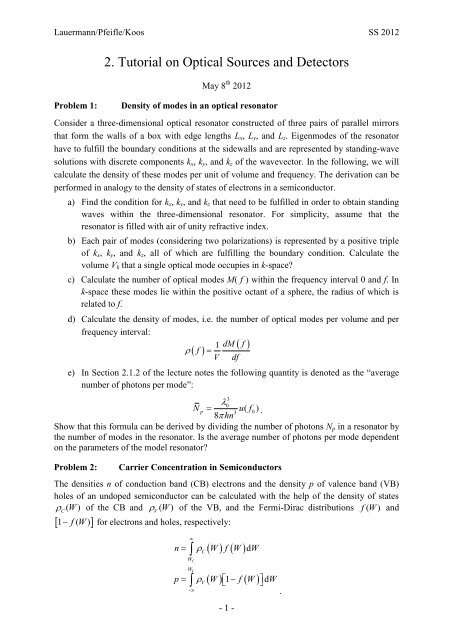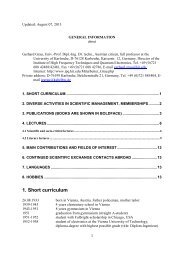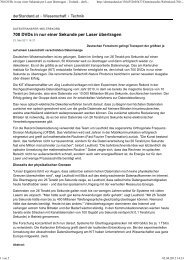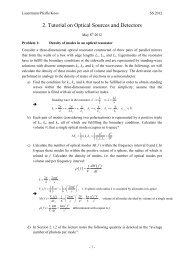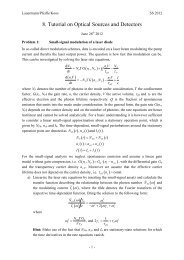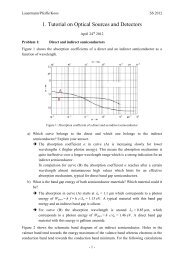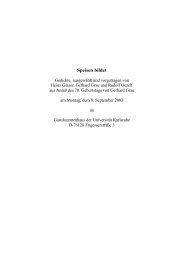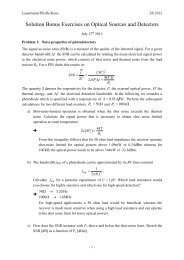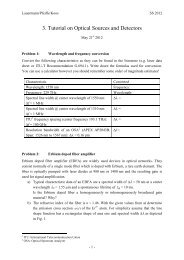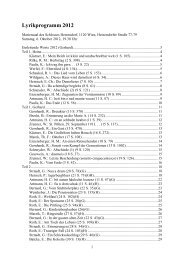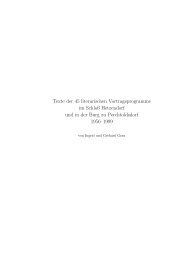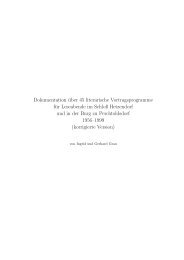Create successful ePaper yourself
Turn your PDF publications into a flip-book with our unique Google optimized e-Paper software.
Lauermann/Pfeifle/Koos SS 2012<br />
2. Tutorial on Optical Sources and Detectors<br />
May 8 th 2012<br />
Problem 1:<br />
Density of modes in an optical resonator<br />
Consider a three-dimensional optical resonator constructed of three pairs of parallel mirrors<br />
that form the walls of a box with edge lengths L x , L y , and L z . Eigenmodes of the resonator<br />
have to fulfill the boundary conditions at the sidewalls and are represented by standing-wave<br />
solutions with discrete components k x , k y , and k z of the wavevector. In the following, we will<br />
calculate the density of these modes per unit of volume and frequency. The derivation can be<br />
performed in analogy to the density of states of electrons in a semiconductor.<br />
a) Find the condition for k x , k y , and k z that need to be fulfilled in order to obtain standing<br />
waves within the three-dimensional resonator. For simplicity, assume that the<br />
resonator is filled with air of unity refractive index.<br />
b) Each pair of modes (considering two polarizations) is represented by a positive triple<br />
of k x , k y , and k z , all of which are fulfilling the boundary condition. Calculate the<br />
volume V k that a single optical mode occupies in k-space?<br />
c) Calculate the number of optical modes M( f ) within the frequency interval 0 and f. In<br />
k-space these modes lie within the positive octant of a sphere, the radius of which is<br />
related to f.<br />
d) Calculate the density of modes, i.e. the number of optical modes per volume and per<br />
frequency interval:<br />
1 dM f <br />
f <br />
V df<br />
e) In Section 2.1.2 of the lecture notes the following quantity is denoted as the “average<br />
number of photons per mode”:<br />
3<br />
0<br />
N<br />
p<br />
u( f<br />
3 0)<br />
.<br />
8<br />
hn<br />
Show that this formula can be derived by dividing the number of photons N p in a resonator by<br />
the number of modes in the resonator. Is the average number of photons per mode dependent<br />
on the parameters of the model resonator?<br />
Problem 2:<br />
Carrier Concentration in Semiconductors<br />
The densities n of conduction band (CB) electrons and the density p of valence band (VB)<br />
holes of an undoped semiconductor can be calculated with the help of the density of states<br />
( ) of the CB and ( W ) of the VB, and the Fermi-Dirac distributions fW ( ) and<br />
<br />
C W<br />
<br />
1 fW ( ) for electrons and holes, respectively:<br />
V<br />
<br />
<br />
<br />
n W f W dW<br />
W<br />
W<br />
C<br />
V<br />
<br />
C<br />
<br />
<br />
p V<br />
W 1 f W dW<br />
-<br />
.<br />
- 1 -
Lauermann/Pfeifle/Koos SS 2012<br />
If the energetic distance of the Fermi level from the band edges is W<br />
,<br />
W 3kT , then the<br />
Fermi functions can be simplified by the Boltzmann approximation<br />
W WF<br />
<br />
f W exp , for W WF<br />
3 kT,<br />
kT <br />
WF<br />
W<br />
<br />
f W 1 exp , for W WF<br />
3 kT,<br />
kT <br />
which shall be used for the calculations below. In practice, however, this condition is usually<br />
not fulfilled, e.g. for a highly doped laser diode, the Fermi level is very close to or even inside<br />
the band. Thus the following considerations show the principle only.<br />
a) Show that the maximum of the electron distribution <br />
energy kT /2 above the band edge W<br />
C<br />
of the CB.<br />
C V<br />
F<br />
W f W<br />
C<br />
is found at the<br />
b) Solve the above given integrals for n and p by using the Boltzmann approximation and<br />
write the carrier concentration as<br />
n<br />
N<br />
p<br />
N<br />
C<br />
V<br />
WC<br />
WF<br />
<br />
exp <br />
kT <br />
,<br />
WF<br />
WV<br />
<br />
exp <br />
kT <br />
where N C and N V are the effective density of states of the CB and VB, respectively.<br />
c) Take the results from b) and determine the energetic distance of the Fermi level<br />
relative to the band edges.<br />
d) The bandgap energy of GaAs is W G = 1.424 eV, the effective masses are m n = 0.067m 0<br />
and m p = 0.48m 0 , where m 0 is the electron rest mass. Determine the intrinsic carrier<br />
concentrations n and p of GaAs at T =300 K by using the results of b).<br />
Problem 3:<br />
Fiber optic communication system<br />
Consider a fiber optic communication system that transmits data with a data rate of 40 Gbit/s<br />
over a distance of 100 km. The data is modulated onto a carrier at 1550 nm and the fiber has<br />
an average attenuation (considering splices etc.) of 0.3 dB/km. The transmitter couples an<br />
average power of 2 mW into this fiber.<br />
Assume that the '0' bits don't carry any power whereas the '1' bits have a constant power<br />
throughout the whole bit slot (non-return-to-zero (NRZ) modulation). Further suppose that the<br />
probability for transmitting a '1' is equal to the probability of transmitting a '0'.<br />
How many photons arrive at the receiver during a single '1' bit?<br />
Questions and Comments:<br />
Matthias Lauermann<br />
Jörg Pfeifle<br />
Building: 30.10, Room: 2.32 Building: 30.10, Room: 2.23<br />
Phone: 0721/608-41695 Phone: 0721/608-48954<br />
Email: Matthias.Lauermann@kit.edu<br />
Email: Joerg.Pfeifle@kit.edu<br />
- 2 -


